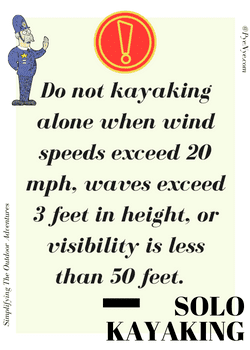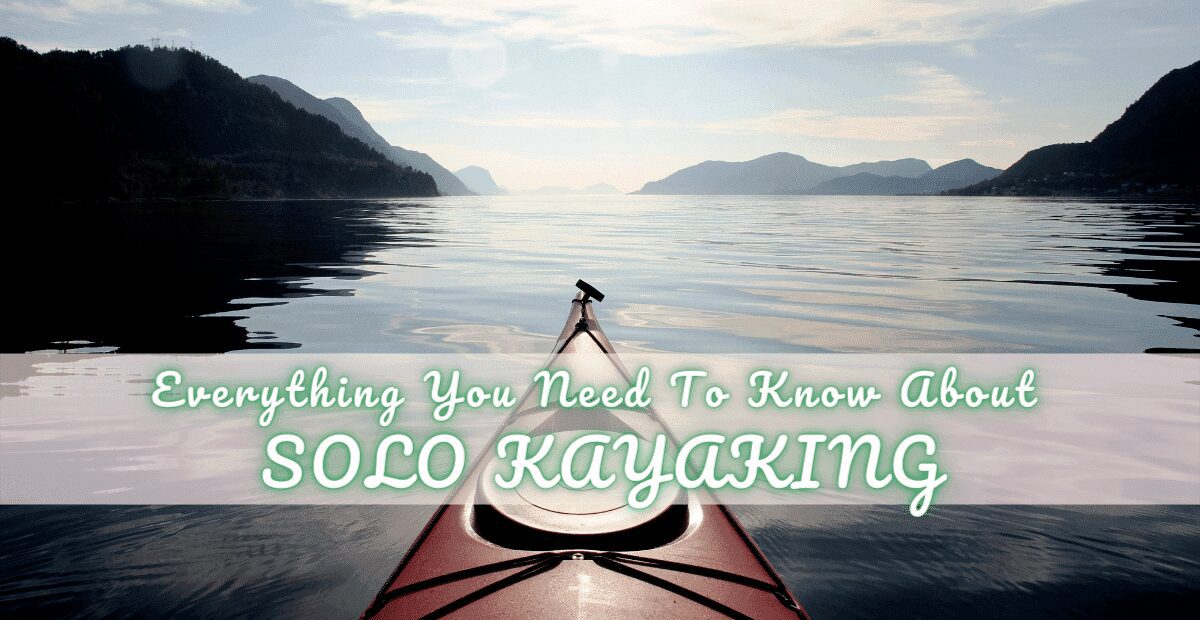Solo kayaking is a great way to get away from it all. It will give you an opportunity to think about your life, goals, and relationships with friends and family. You may realize that the one thing you need most in order to feel fulfilled is time for yourself. And solo kayaking allows for this kind of reflection.
Overall, kayaking on your own is a great way to experience the world around you, and it can be very rewarding. You will live like a nomad and find new ways of exploring nature!
If you’re not sure if kayaking alone is for you, learn how to plan kayaking trips first! Because kayaking on your own can become too adventurous for newbies. In this article, we’ll be discussing everything you need to know about solo kayaking trips. Let’s dive in;

Kayaking alone can be a great way to spend a day, but only if safe water conditions. The Coast Guard recommends not kayaking alone when wind speeds exceed 20 mph, waves exceed 3 feet in height, or visibility is less than 50 feet.
However, there are some risks that must be considered when going out alone. When you plan for a solo kayaking trip, you should always wear a lifejacket and reflective gear, as the boat may not last long in the event of an emergency. Above all, kayaking alone can be a great way to spend a day, but only if safe water conditions. Here’s more on what to wear on kayaking trips.
Jump To A Section
Is solo kayaking safe?
Many people enjoy the peace and quiet of kayaking on their own. However, solo kayaking is not without its fair share of risks. Kayaking alone can be a daunting task for some of us. The reasons for this vary. Some people fear the possibility of feeling isolated or not being able to paddle themselves out of trouble if something goes wrong. Others worry about being preyed on by other water-based predators if they are alone in the wilderness!
But if it’s winter, you should be more careful. You can get the winter kayaking guidelines from here. We recommend not going far during the winter months when you’re kayaking alone.
Solo kayakers face exposure to harsh waves and weather conditions as well as the risk of dehydration and hypothermia. Moreover, solo kayakers can be at risk for drowning if they capsize or are pinned underwater due to their boat flipping. However, you can have a look at the kayaking safety checklist from here.

When should you not go kayaking alone?
If you enjoy kayaking, then you know that it can be a lot of fun. However, there are some risks that should not be taken when kayaking alone. The first risk is the distance between where you start kayaking and where you end up. If you are not very familiar with the spot you are going to kayak at, then this distance could get very long.
Kayaking alone can be a great way to spend a day, but only if the water conditions are safe. The Coast Guard recommends not kayaking alone when wind speeds exceed 20 mph, waves exceed 3 feet in height, or visibility is less than 50 feet.
If you know the water well and have experience paddling in it, then it’s usually ok to go kayaking alone. But if you’re new to the area or don’t know the water well, it’s best to bring at least one companion with you who knows kayaking too.
Solo Kayaking Guidelines And Tips For Alone Kayaking
Solo kayaking is a great way to have a solitary adventure that will leave you feeling refreshed and energized.
There are some solo kayaking tips that you need to know if you want to enjoy the activity without paddling with a partner. This can be a challenging activity, so it’s best to learn how to safely perform this activity first.
The First And Foremost
Use a personal flotation device when kayaking alone, and always wear a life jacket. You should also know how to perform self-rescue and be aware of your surroundings.
Practice Re-Entry skills
Practice re-entry skills before you are planning for kayaking alone. Many kayakers panic if they fall in the water. Be sure to make your kayak buoyant before you head out so you can float when you’re panicked. The re-entry skills you learn will be extremely helpful if an emergency should arise. In case you find yourself in a difficult situation, it will be easier to get out of the kayak and try again.
Know-How Far Can You Go!
Knowing your limits is necessarily important for solo kayaking trips. Remember, you’re a vulnerable person when you’re kayaking alone. You’re much more vulnerable to predators. Avoid areas where you’ll have to share the water with other powered vessels.
If you’re kayaking alone, you’ll want to paddle at least 50 yards from shore. If you’re camping and kayaking near a place where there are wild animals, you’ll have to stay away from them.
However, before buying an inflatable kayak, know how safe are inflatable kayaks?
Be Prepared For The Unexpected Situation
Prepare for the unexpected situation when you are kayaking alone. Even if you’re kayaking on Lake Powell, a calm water lake, it’s likely that you’ll fall into the water in a situation where you’re alone. If the weather is rough, like ocean kayaking, it’s best to make the kayak buoyant and wear light-colored clothing. You should also remember to keep an eye out for wildlife and be alert to your surroundings. You should keep an eye on the weather conditions and make sure you’re not a danger to other boaters.
Concentrate On Your Outfits
Dress appropriately. The weather should be calm when kayaking in a peaceful lake. You’ll have a lot of time to relax and enjoy the beautiful scenery, which is why you’ll be a lot happier after the trip. And, of course, make sure to be comfortable in the environment you’re kayaking in. This will help you avoid getting into any trouble. The weather is an essential factor when you’re out on the water.
Practice The Safety Lessons Carefully
While solo kayaking, you should carry sunscreen, sunglasses, and a cell phone. The waterproof bags you use should be easily accessible from the safety gear. It’s not a time for grand adventures. If you’re going to kayak alone, it’s best to find some familiar waters with lots of lands. You’ll be safer if you follow these solo kayaking tips. When you’re kayaking alone, keep yourself safe by taking a few precautions, and you’ll be fine.
Value The Safety Gears
Make sure to pack the right safety gear. A life jacket is a must-have for any water activity, and a kayaker should be sure to have one while kayaking alone. The life jacket can help save your life in case of an accident or other mishap. Remember to check the fit of your life jacket before leaving home. While paddling solo, you should also be aware of your surroundings and wear clothes that are easy to spot.
Common Dangers of Kayaking Alone
Kayaking alone is not the best idea for beginners! Many lakes can be dangerous, and you may not be aware of the potential hazards. Always make sure to check the weather before heading out to the water. Thunder and lightning are very common, but they usually only strike higher objects, like buildings or cars. It is also important to be vigilant and watch for clouds in the sky. High winds can quickly overwhelm a small watercraft. To reduce the risk of being swamped by a storm, check marine weather forecasts in advance. The National Weather Service provides this information for free.
Another danger that kayakers can face is a passing boat. Large ships can jolt their paddles, unsettle them, and may not be able to see you. This is why it is important to stay visible by wearing bright-colored clothing and attaching a safety vest. It is also important to keep a paddle in front of you so you can be seen by passing boats. If you must kayak alone, always make sure to paddle against the current and be aware of the surroundings.
While kayaking alone, be aware of the dangers of being alone in the water. For example, large ships can cause damage to a kayak. Be aware of the weather conditions and prepare accordingly. It is especially dangerous to kayak in freezing water. You need to wear layers of clothing to protect yourself from the cold water. You should also paddle in calm water and close to the shore if possible. Otherwise, your paddle will only break if you get caught in a capsize.
Why I love kayaking alone
Kayaking alone is a great way to clear my head and get my mind off everything else. Getting outside and being with nature has helped me become more grounded. When I am out on the water, I can focus on nothing but what is in front of me, which gives me a break from the busyness of life. One day, kayaking alone for about an hour, I came across a mother otter eating a fish she had just caught.
Being alone on a kayaking excursion is my favorite. I love kayaking alone as it’s so relaxing to be out on the water with nothing else to focus on but the horizon!
I love the feel of the wind in my hair and the way my muscles burn with each stroke or paddling motion. I’ve been going out by myself for close to a year now and have always returned refreshed and rejuvenated.
Sometimes I bring my kayak fishing setup if I’m feeling adventurous, but it’s so nice being able to get away from everything for a while.
Kayaking alone is a great way to clear my head and get my mind off everything else. Getting outside and being with nature has helped me become more grounded. When I am out on the water, I can focus on nothing but what is in front of me, which gives me a break from the busyness of life. One day, kayaking alone for about an hour, I came across a mother otter eating a fish she had just caught.
In conclusion, solo kayaking is an excellent way to reconnect with oneself and explore the beauty of nature. Kayaking alone is a rewarding experience that will test your abilities and push you to your limits. It is best to do it with someone else, but solo kayaking is an excellent way to find yourself and who you are as an individual.


